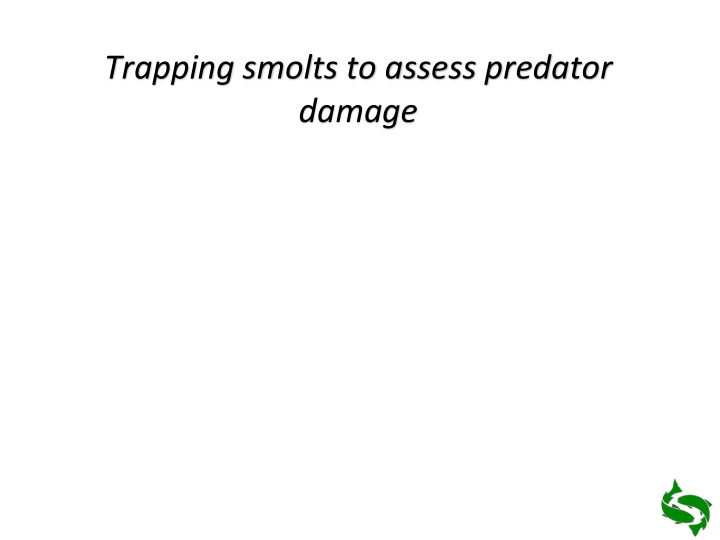



Trapping smolts to assess predator damage
The types of damage found on smolts are recorded by reference to a set of photographs Most of these types were identified at a smolt trap on the R. Ness ( Williams, K., 2007: Nutrient Transport Associated with the Migrations of Atlantic salmon (Salmo salar L.). Unpublished Ph D, Cardiff University) Three other types been identified here, to make 10 in all
Type I – Scales removed, including ‘rake marks’ / areas of parallel scale loss. Type II – Scales removed, including converging lines or ‘v’ -shaped areas of scale loss
Type III – Single, small, puncture wound Type IV – Single, large, puncture wound
Type V – Multiple, small, puncture wounds Type VI – Multiple puncture wounds, including one or more large ones
Type VII – General scale loss or other damage types
ADDED : Type VIII – U-shaped bite from below ADDED : Type IX – Upper lobe of tail damaged ADDED : Type X – Lower lobe of tail damaged If any damage type occurs on the wrist of the tail, put a ring round its number when recording
WHAT CAUSES THESE DIFFERENT TYPES OF DAMAGE ?
Type I – Scales removed, including ‘rake marks’ / areas of parallel scale loss. Smolts known to have been regurgitated by Goosanders
ADDED : Type VIII – U-shaped bite from below Have also seen this type in a stream where only Eels and Trout are present, so must be the mark of one of these
Heron ? But not seen at smolt traps, only on Autumn traps for upstream migrants
Damage rates % Damaged (I & II) TYPES OF DAMAGE FOUND TOTALS damaged % Bird Damaged Smolts I II III IV V VI VII VIII IX X XI XII 2011 Salmon 4 12 0 0 0 0 24 5 1 2 8 0 56 509 11.00% 3.14% Trout none 0 52 0.00% 0.00% 2012 Salmon 8 12 0 1 0 0 2 1 0 2 1 0 27 359 7.52% 5.57% Trout 1 5 1 0 0 1 1 1 0 0 0 0 10 90 11.11% 6.67% But are unsuccessful attacks a high or low proportion of all attacks made? How many survivors of unsuccessful attack die afterwards – and how might it take them to die?
Damage on an adult: by what?
Inter cohort competition apparent in downstream emigrants ? 25 25 2002 n=1389 2003 n=3974 20 20 PERCENT PERCENT 15 15 10 10 5 5 0 0 50 80 110 140 170 200 230 50 80 110 140 170 200 230 25 25 LENGTH LENGTH 2005 n=2224 2004 n=3114 20 20 PERCENT PERCENT 15 15 10 10 5 5 0 0 50 80 110 140 170 200 230 50 80 110 140 170 200 230 25 LENGTH 25 LENGTH 2006 n=1316 2007 n=890 20 20 PERCENT PERCENT 15 15 10 10 5 5 0 0 50 80 110 140 170 200 230 50 80 110 140 170 200 230 LENGTH 25 25 LENGTH 2008 n=546 2009 n=789 20 20 PERCENT PERCENT 15 15 10 10 5 5 0 0 50 80 110 140 170 200 230 50 80 110 140 170 200 230 LENGTH LENGTH
Inter cohort competition apparent in downstream emigrants ? 25 25 2010 n=329 2011 n=655 20 20 PERCENT PERCENT 15 15 10 10 5 5 0 0 50 80 110 140 170 200 230 50 80 110 140 170 200 230 LENGTH 25 LENGTH 2012 n=238 20 PERCENT 15 10 5 0 50 80 110 140 170 200 230 LENGTH
SMOLT AGES – No S3s ? 700 S1 600 S2 S3 500 NUMBER 400 300 200 100 0 85 90 95 100 105 110 115 120 125 130 135 140 145 150 155 160 LENGTH (5mm)
SMOLT AGES – No S3s ? S2+ or S3s without the final winter band forming?
Recommend
More recommend